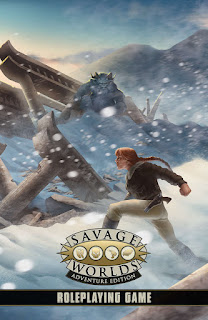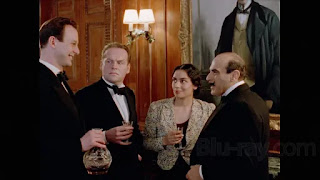Jonathan L. Howard, Johannes Cabal: The Fear Institute
Among the genre books that try for humor, Jonathan L. Howard's Johannes Cabal books are unmatched; never treacly, there's a meanness that cuts through anything cloying. The Fear Institute finds Johannes Cabal guiding a group of men through the Lovecraftian Dreamlands in search of the essence of fear. The amazing thing about this series is that while they're mostly droll humor and madcap adventure, they sometimes manage to also offer a moment of utter heartbreak. Consider having some tissues handy when you read The Fear Institute.
Dream Unending, Song of Salvation
The notion of "Sabbath worship" is all too familiar to anyone who listens to doom metal, but it's nice to see Dream Unending back so soon with another album brimming with "Peaceville Three worship." And they really do give a nod to each of the major Peaceville bands on Song of Salvation. Joining those classic sonic aesthetics are elements that feel a little proggy ala Pink Floyd and even a few moments that wouldn't be out of place on the Projekt roster.
Wednesday
Against all odds, Wednesday is actually pretty fun! The show is largely carried by how well Jenna Ortega manages to inhabit the character and present a laudable version of the Addams's daughter, but the supporting cast (particularly Gwendolyn Christie and Christina Ricci) also turn in some great performances. One thing that was a little surprising was how willing they were to write Wednesday as a pretty terrible person in a lot of ways. Don't go into expecting something gob-smacking and you may just be surprised.
Years ago, Savage Worlds was one of the mainstay roleplaying games in my rotation, but with a change in gaming groups interest in it waned off. I knew that a new edition of the game had come out, but I didn't really look into it too deeply...until now. I haven't made a full study of it, but so far the changes to the system look pretty well-conceived. I even got to kick the tires a bit in December by running a session of Planet Motherfucker using the Adventure's Edition rules. The art still feels a bit naff--particularly that uninspiring cover--and I lament that it's no longer the budget-friendly game it once was, but you do get a lot of game in one hardback.
The English
I love a Western in general, but The English, a six-part miniseries, is absolutely exquisite. Beautifully filmed, what at first glance feels like a standard tale of revenge instead turns into a story of redemption. As the series progresses, it really piles on the Gothic grotesquery, and the final episode pack a powerful emotional gut-punch. Absolutely worth your time. The further I got into The English, the more I was convinced that it was the best thing on "tv" in 2022.
Dragonlance: Shadow of the Dragon Queen
Even though I grew up reading the Dragonlance novels, I can't say it has ever been one of my favorite fantasy settings. Surprisingly, Shadow of the Dragon Queen looks like a pretty solid campaign in my quick read-through. Rather than a re-hash of the original series of modules, it shifts the focus to another part of the burgeoning War of the Lance. Also, I think it's an extremely cool idea to focus on a villain based on the Red Barron and dogfighting in a setting that prominently features dragon riding. Even her name, Red Ruin, feels inspired.
I'll also note that the art in Shadow of the Dragon Queen feels more "classic fantasy" than the modern. whimsical style that WotC has been moving toward lately. Which is a win for me because I definitely have a preference for the former over the latter.
Cullen Bunn, Joelle Jones, and Nick Filardi, Helheim, Book 1: The Witch War and Book 2: Brides of Helheim
In the first book of Helheim, Vikings are caught in a war between two witches: one who transforms her servants into demons and one who commands legions of the dead. Enter a fallen warrior who has been reanimated as a champion of one witch, and infused with the demonic essence summoned by the other. Now on his own path, he seeks to slay both witches and free his people from their burden.
In the second book, the draugr is once again called upon, but this time he must face the warlock who tutored the three witches from the first volume. This book, more so than the first, feels like a full-bore rush into sword & sorcery themes and aesthetics. Mighty (undead) thews!
The Menu
I quite enjoyed watching The Menu, but if we're being fair it does pander to me specifically in a number of ways. Chief among them is the premise that people who are into fancy food deserve to be murdered. I doubt that The Menu will blow anyone away, but it's definitely a solid movie. One thing about it that I keep thinking about is how it captures the events of a single night; chronologically terse, it has the space to focus on moment to moment nuance in ways that films that are more temporally expansive often can't manage.
Worm, Bluenothing
Last year, Worm captured the boggy, fetid oppression of the swampland on Foreverglade. With their Bluenothing ep they dive into stranger territory. Bluenothing takes more inspiration from symphonic black metal than filthy death doom; and yet, even despite that sonic core in place, Bluenothing is also often a showcase for virtuoso soloing that maybe wouldn't be out of place in something more spandex-attired. If Bad Books for Bad People had a "best EP" category for our end of year wrap up, I might just go with this one as my pick.
I don't have many Christmas traditions, but reading last year's volume of The Valancourt Book of Victorian Christmas Ghost Stories is one of them. Volume Five is a fine addition to the series, offering a wide variety of Christmas ghost stories and the occasional seasonally haunting poem. For me, the stand out of this volume was Barry Pain's "The Undying Thing," in which a child is born monstrous and abandoned in a cave, only to haunt a family line, killing off the generations until none remain. Merry Christmas, everyone!
Rainbow, Self-Titled and Rising
After last month's dive in Dio's catalog, I decided it would be a great idea to revisit the first two Rainbow albums with Dio on vocals. If the Dio albums illustrate what we've lost now that rock songs no longer focus on rockin', the Rainbow albums also hint at how the genre becomes impoverished once divorced from some vaguely mystical trappings. Hell, even bands like the Pixies made some space for Frank Black's UFO fixations. Bring back the haze, man.
My newfound obsession with the works of Agatha Christie continued with The ABC Murders, a novel in which Poirot receives taunting letters from an assassin committing alphabetical murders; moving through the alphabet from A-Z, the killer is murdering someone who name starts with the same letter as the scene of the crime. The early portions feel somewhat different from the other Poirot novels I've read, as it first it appears that the motive is the art of crime itself, with no connection to a deeper human motive. Also of interest is the way that The ABC Murders functions as a commentary on the effects of age, particularly on men.
It had been a while since I started a manga series, so I decided to give Shiwo Komeyama's Bloody Cross a try. The story, so far, is about two half-angel, half-vampires who find themselves united by an occult curse after they both try to double-cross each other. Forced to work together to find the remedy for their mutual curse, they vacillate between partnership and betrayal, with a side order of "will they, won't they" horniness. The events of the volumes I read find the unlikely pair chasing down holy relics in a race to see who will become the next God (???)
P.L. McMillan, Sisters of the Crimson Vine
In Sisters of the Crimson Vine, a man finds himself hideously injured after a car wreck, but he's rescued and nursed back to health by a rather unconventional convent of nuns. With nary a crucifix, Bible, or wimple to be found, there is clearly something strange going on with this holy order. In fact, a Catholic priest and his acolyte are also staying at the convent, ostensibly to look over the convent's finances and correct any heretical lapses of faith. The novella deftly mixes classic Gothic conventions, folk horror, and a bit of nunsploitation to craft a fairly heady, if slight, vintage. I honestly wouldn't have minded in the least to have this tale exploded out into a full novel.
Big, dramatic Gothic metal isn't currently en vogue, so it's a bit hard to find new examples of the genre. Luckily, there always seems to be a never-ending sea of bands with extensive back catalogs to rifle through when the opportunity presents itself. Enter The Vision Bleak, a band with a long and varied history that I had never checked out before. The Vision Bleak have the melancholic vocals I sometimes crave, paired with dirge-like metal, but they also offer some surprisingly thrashy moments, full-on black metal elements, some Rammstein-esque bits, and even some spots where things get a little proggy. But not too proggy, if you catch my meaning.
Julia Gfrorer's Vanitas is a wordless minicomic in zine form that spins a tale of innocence and corruption. With its lepers, unicorns, and peasants, Vanitas has the feel of being Arthurian-adjacent, but the lack of any valorous knights and the like underlines how this is a tale of common folk and their own extraordinary capacities for good and ill.
Of course, after finishing the novel of The ABC Murders, I decided to chase it with an adaptation. Luckily, Sarah Phelps, who wrote the adaptation of And Then There Were None that I enjoyed immensely last month, also wrote the screenplay for The ABC Murders adaptation that stars John Malkovich as Poirot. Although I didn't enjoy this one quite as much as And Then There Were None (I'm not quite convinced by Malkovich's Poirot and the whole thing leans too far into "gritty Poirot reboot" for my tastes), there are definitely elements here that are praiseworthy.
Man, Dan Abnett really knows how to plot an inquisitorial mystery! Ravenor and the gang return to the planet where their last adventure really got underway, but they find themselves embroiled in a plot that goes deeper than they could have imagined; what seemed like the prospect of busting a drug cartel has turned into thwarting a chaos cult from taking hold of the very language of creation itself. The way that Abnett has factored the mindless bureaucracy of the Imperium as a plot point in Ravenor Returned is, frankly, pretty damn brilliant. The real horror is pointless office jobs.
It's pretty cool that after two previous volumes of Tome of Beasts, and Creature Codex as well, there were still enough monstrous ideas left for Kobold Press to make Tome of Beasts III. You might expect this book to collect some stray dregs, but there's still a lot of great monsters for any 5e game here. The Tome of Beasts series is especially noteworthy for filling in some gaps in the official offerings in terms of monsters from certain kinds of terrain and monsters of specific types that haven't been fully explored in WotC's monster books. Also, unlike a lot of third-party content, the stats here are of a uniformly high quality.
This is how I got into the Christmas spirit this year. A Holiday for Murder sets a particular fine scene: a tyrannical patriarch invites his family to stay with him for the holidays; of course, this is not motivated by good will, but rather because the old man wants one more chance to fuck with them, even though they already hate his guts. But he holds the family purse strings, so of course they arrive at the ancestral seat. When the aged rascal is murdered, Poirot is called in to assist with the investigation and determine which family member offed the old coot.
I finally got my hands on the final trade paperback volume of Moonshine at the end of December. As you might imagine, the various factions in play throughout Moonshine's run, which include gangsters, hillbilly rumrunners, a werewolf seductress, a witch, and the comic's extremely troubled protagonist, all make final stands against each other with predictably violent and explosive results. The ending feels a tad bit rushed, but at the same time I appreciate how compact the storytelling is and that the title comes to a fairly conclusive endpoint.
Did I watch the David Suchet-helmed adaptation of A Holiday for Murder as soon as I was done reading it? You bet your ass I did. The adaptation cuts down on the prodigious cast of characters, conflating a few of the players, but I think that's the right move for a tv version like this. You only get so much screen time, so you have to make it count.
I had a bad night's sleep that left me too unfocused to read anything more substantial, but luckily this collection of Marvel's Sisters of Battle comics had just come in the mail. Just what the doctor ordered. Unsurprisingly, Sisters of Battle is an action-oriented comic; members of the Adepta Sororitas are sent to extract an agent of the Inquisition from a mining colony that appears to have succumbed to the corrupting influence of Chaos, which tests their faith, resolve, and capacity for violence in the name of the Emperor of Mankind. Not many surprises, but the comic does leverage the 40k universe to good effect.
























No comments:
Post a Comment